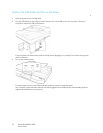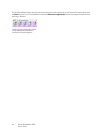
Xerox
®
DocuMate
®
4830
User’s Guide
40
Scanning from the Automatic Document Feeder
(ADF)
Documents to Avoid Scanning
The documents in this list can be scanned, but please note that scanning documents of this type will reduce the life
of the scanner. Maintenance will be required more often and replaceable parts will wear faster. These types of
documents will jam more frequently and damage to the original documents may occur. If you do choose to scan
these document types, do not scan large batches. This type of use is not covered under the scanner warranty and
alters replacement parts life expectancy.
We recommend you limit the amount or completely avoid scanning documents that are in this list.
• Curled, wrinkled or folded documents may cause paper jams or multiple pages being fed through the scanner
at one time.
• Perforated or punched paper that could tear when the separation roller engages.
• Coated paper or photographs where the coating can flake off during scanning and leave residue in the
scanner.
• Extremely smooth, shiny, or highly textured paper may cause the paper feed rollers to slip across the page and
cause the scanner to report a paper jam.
• Carbonless copy paper may tear while being fed through the scanner and the pressure of the rollers may leave
streaks on the page. The chemical coating on this paper will rub off on the rollers during the scan process,
increasing the frequency of miss-feeds and paper jams.
• Partially transparent paper such as tracing paper as any images from the opposite side of the page or black
background will appear in the scanned images.
Unsupported Document Types
Do not scan the following types of documents as they may cause damage to the scanner.
• Items outside of the specified supported sizes, thickness, and weight defined in this document.
• Non-rectangular or irregularly shaped paper will cause the scanner to detect and report document skew errors
or paper jams.
• Carbon paper that will leave residue in the scanner and on the rollers that will transfer to the next set of
documents scanned.
• Documents with hard items attached such as paper clips, binder clips, and staples.
• Documents with wet ink or white-out.
• Thermal or photosensitive paper.
• Overhead projector sheets, plastic film, camera film, and any other type of transparent or partially transparent
plastic item.
• Documents that have been glued together.
• Cloth or metallic sheets.


















